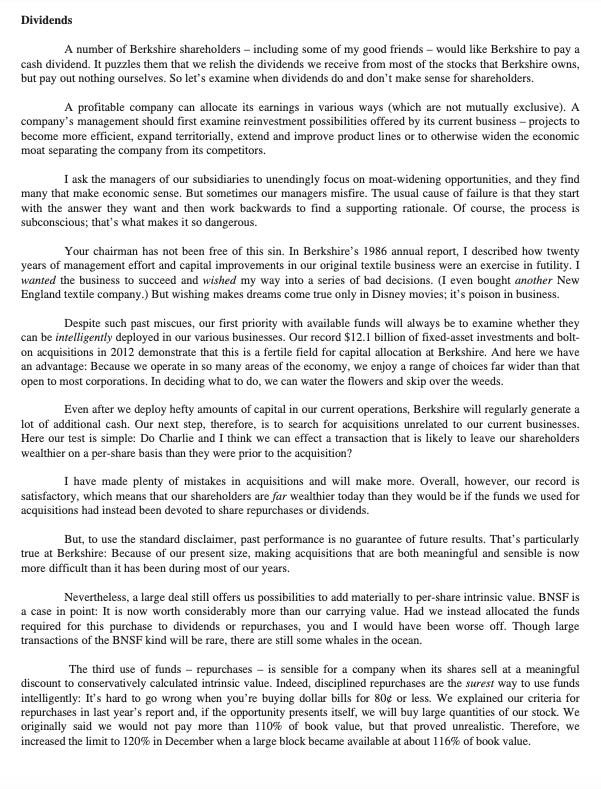Capital & Clarity: Framework for Distributing Capital
How Founders Should Think About Dividends
“Our preference is to retain earnings when we see decent prospects to deploy them at high rates of return. The reasoning is simple: If you are a shareholder, you are better off when the company reinvests your money to generate more earnings rather than paying it out in dividends—so long as the company can do so at a high rate of return.” - Warren Buffet
My team works with brands that are growing and are profitable. The question of how much capital to distribute and at what frequency comes up quarterly. We did this exercise several times last month, so I figured it’d be best to write about it and share our thoughts publicly.
It’s beyond just pulling a small % of your net income. This is a strategic decision that anchors around cash flow discipline.
The best way to determine available cash for distribution is by understanding your free cash flow (FCF) after business needs. Here’s the formula I use:
Distributable cash = (operating cash flow - capex - debt payments - minimum cash reserve - growth investment)
This will help ensure you’re not depriving the business of necessary cash for opex and growth. A quick breakdown of each component:
Operating cash flow measures the cash your company generates from normal business operations. You’ll find this in your cash flow statement (CFS).
OCF = (Net Income + Depreciation & Amortization) - Changes in Working Capital
Capital expenditures (capex) are funds you use to acquire, upgrade, and expand your physical asset footprint. This considers expanding warehouses, buying more equipment, opening new store locations, etc., into account. This becomes prevalent as you verticalize your business.
Debt payments focused on working capital lines, term loans, etc. Be sure to subtract principal and interest payments to view interest expense properly.
Minimum cash reserve: there’s no hard and fast rule here. I prefer at least 3 months of opex in reserve for comfort.
Cash reserve = monthly operating expenses x 3 months
Growth investments can include incremental growth initiatives in marketing, expanding inventory buys, new product development, retail distribution fees, etc. If you’re scaling fast, I typically refrain from distributing capital for brands.
Here’s a simple calculation for reference:
Assumptions
Net Income: $1.5M
Depreciation & Amortization: $100K
Changes in Working Capital: $250K due to inventory buildup
Capital Expenditures: $200K
Debt Payments: $150K
Minimum Cash Reserve: $500K (3 months of opex)
Growth Investments: $400K (TV and podcast marketing test + new product launch)
Step-by-Step Calculation
Operating Cash Flow: OCF = (1,500,000 + 100,000) - 250,000 = 1,350,000
Free Cash Flow: FCF = 1,350,000 - 200,000 = 1,150,000
Distributable Cash: 1,150,000 - 150,000 = 1,000,000
Now, the founders have two options: to invest in future growth or distribute.
Option A. Non-Ideal Distribution: 1,000,000 - 500,000 = 500,000
Option B. Ideal Distributable Amount: 500,000 - 400,000 = 100,000
My team focuses on maximizing shareholder value, which generally means delayed gratification in distributing capital. There are plenty of reasons for this. Most consumer brands are LLCs taxed as C-corps, meaning any distribution is double taxed. If they’re structured as S-corps or partnerships, then it’s a passthrough. In either case, it’s ordinary income.
I want our founders to focus on increasing enterprise value and focus on capital gains opportunity.
However, for family-owned businesses that have no institutional investors, have healthy balance sheets, and generate free cash flow, we will always be a proponent of distributing capital.
As an aside, if you’re a consumer brand and not a C-corp, you should consult with your CPA and discuss QSBS and IRS code 1202. I’m not a CPA, but they can walk you through this— it’s valuable if you want to explore a transaction in the future.
Final Thoughts
These are the key items my CFOs and accountants run into. I call them “anchor points” when we are leading a client engagement.
Watch inventory cycles: you can’t distribute cash if it’s tied up in upcoming inventory.
Marketing & growth investments matter: but perhaps more important, measurement and attribution matters above all. Track your contribution margin impact frequently. Use your P&L as your source of truth. There are a lot of paid media attribution tools out there— use them as directional insights.
Keep cash reserves healthy: cash flow is the lifeblood of a fast-growing brand. Have at least 2-3 months of opex to handle volatility.
Reinvest first, distribute second: if you’re growing, prioritize reinvesting profits back into growth. Prioritize your capital gains income opportunity and focus on increasing enterprise value vs. ordinary income.
Lastly, if you'd like Warren’s perspective on dividends and distributing capital, here’s a little snippet from his 2012 letter (link here, scroll to page 18).
Note: This letter is an “over the counter” POV on distributing capital and is not “prescriptive.” As always, talk to your head of finance / CFO about specifics.
What I am reading:
Hermes published its annual report (link here). It’s fantastic. Annual reports for family owned businesses reveal subtle insights— beyond financial performance, you’ll observe how they think about capital allocation. My takeaways:
APAC region continues to be dominant whilst middle east is growing
Deepening it’s roots in vertical integration and core focus on craftsmanship model
Leaning into consumables - perfume and beauty can become a key sector
Hermes is a master class at growing value while maintaining exclusivity:
$15.1B in top line revenue
70% gross margin
40.5% operating income (it’s grown from historically low 30% to 40%+)
I’m enamored by high-end luxury brands. I’ll listen to any podcast or read random blogs on Patek Philippe, Rolex, Ferrari, etc. Hermes is the king of the hill, and it maintains its independent status while other major players eventually sell to a Richemont Group or LVMH; Hermes has found a way to stay focused for 188 years…





